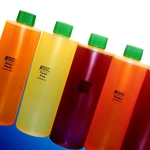

Sodium Hydroxide (Caustic Soda, Lye)
Sodium Hydroxide, also known as Lye and Caustic Soda, is a compound with the formula NaOH.
Sodium hydroxide is a highly caustic base and alkali that decomposes proteins at ordinary ambient temperatures and may cause several chemical burns.
As one of the simplest hydroxides, sodium hydroxide is frequently used alongside neutral water and acid to demonstrate the pH scale to chemistry students.
Sodium hydroxide is used in many industries: in the manufacture of pulp and paper, textiles, drinking water, soaps and detergents, and as a drain cleaner (active ingredient of “Drano”).
Food uses of sodium hydroxide include washing or chemical peeling of fruits and vegetables, chocolate and cocoa processing, caramel coloring production, poultry scalding, soft drink processing and thickening ice cream. Olives are often soaked in sodium hydroxide for softening; Pretzels and German lye rolls are glazed with a sodium hydroxide solution before baking to make them crisp.
It is hard to believe. You can actually make the much more reactive Sodium Metal by burning a mixture of Sodium Hydroxide and Magnesium metal (also listed by us on Ebay) due to the lower enthalpy of formation of magnesium oxide than that of sodium hydroxide. Isn’t thermal chemistry wonderful? I am not allowed to provide the links here. But you can easily find several how-to videos by searching for “Sodium metal from Magnesium”, or “Sodium metal from Sodium Hydroxide”.







